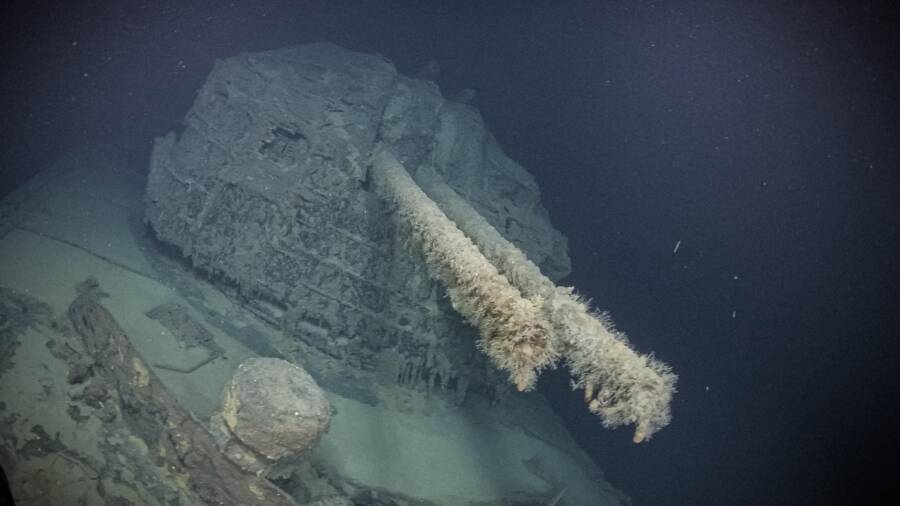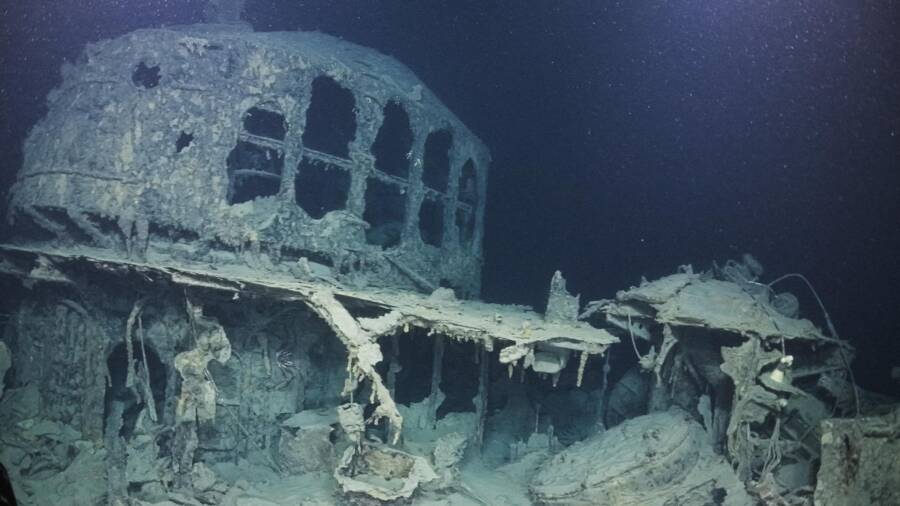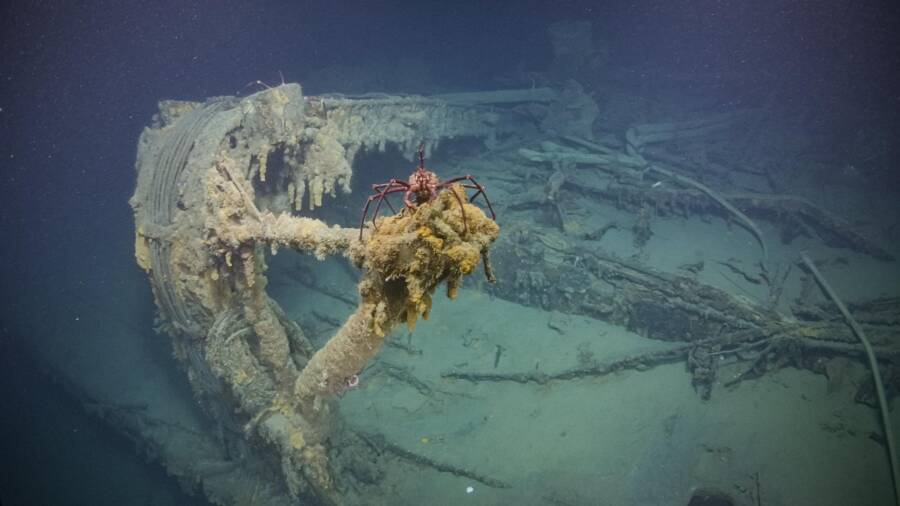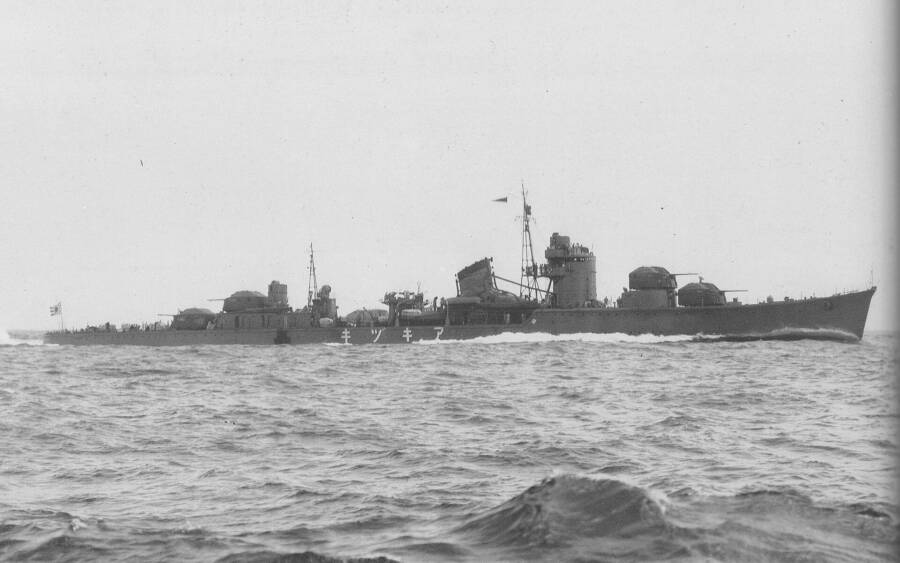On December 12, 1942, the Japanese destroyer Teruzuki was sailing through the Solomon Islands when it was suddenly struck by two American torpedoes, setting the ship ablaze and soon sending it to the bottom of the Pacific.

Ocean Exploration TrustThe Teruzuki was found 2,600 feet beneath the surface of the sea.
Archaeologists recently located and photographed a World War II Japanese ship that sank more than 80 years ago.
The ship is believed to be the Teruzuki, a Japanese Navy destroyer. It sank in the Pacific on December 12, 1942 after being hit by two American torpedoes.
The Teruzuki was discovered during a project conducted by multiple institutions, including Ocean Exploration Trust, the Naval History and Heritage Command, and NOAA Ocean Exploration. The wreck was found near the island of Guadalcanal in the Solomon Islands, in an area nicknamed “Iron Bottom Sound” due to all the World War II wrecks that lie there.
The Discovery Of The Teruzuki On The Floor Of “Iron Bottom Sound”

Ocean Exploration TrustThe ship was found in an area where more than 100 vessels went down during World War II.
The Teruzuki was discovered more than 2,600 feet below the surface of the sea, according to a statement from the Naval History and Heritage Command. It was found between the islands of Guadalcanal, Savo, and Nggela in the Solomon Islands.
This area was called “Iron Bottom Sound” by soldiers during World War II due to the large number of ships that sank there. From August to December 1942, five major battles took place there, resulting in the losses of 111 vessels, 1,450 planes, and more than 20,000 lives.
The wreck of the Teruzuki was first found by the uncrewed ship DriX, operated by the University of New Hampshire, while conducting scans of the seafloor in order to map the site.
“We didn’t know what it was,” said Larry Mayer, director of the Center for Coastal and Ocean Mapping at the University of New Hampshire. “It hadn’t been identified before.”
Later, researchers sent two remotely-operated vehicles down to the wreck to capture high-quality photos to determine what the vessel was and who it belonged to. The team was able to confirm that the ship they found was the Teruzuki thanks to high-quality images and other historical analysis.
“The original shape is still in excellent condition, and considering the appearance of the gun turrets, there’s no doubt it’s the Teruzuki,” Kazushige Todaka, director of the Kure Maritime Museum in Hiroshima, told The Japan News.
How The Teruzuki Sank In The Solomon Islands During The Guadalcanal Campaign

Ocean Exploration TrustThe Teruzuki took part in the Guadalcanal campaign in late 1942.
The Teruzuki, which translates to “shining moon,” measures 440 feet long and was commissioned in 1942. It was built to defend fellow Japanese aircraft carriers from enemy aerial fire.
The ship was used in the Guadalcanal campaign, a series of battles that would become a turning point in favor of the Allied powers during World War II. The vessel served as the flagship of Rear Admiral Raizō Tanaka.
On December 12, 1942, two American Mk-8 torpedoes hit the Teruzuki near Cape Esperance. The strike disabled the rudders and the vessel started to go up in flames before finally sinking. Nine crew members died as a result, but most of the hundreds of other crewmembers, including Tanaka, survived.

Ocean Exploration TrustNo historical photos of the Teruzuki are known to exist, but it would’ve looked like the Akisuki, its sister ship, seen in the image above.
“I feel so lucky to see this ship. The fact that we have not seen Teruzuki in over 80 years underscores the importance of recording maritime heritage now,” said Hiroshi Ishii, a maritime archaeologist at Kyoto University.
The Teruzuki isn’t the first wreck to be discovered in “Iron Bottom Sound” this year. The same group of researchers behind this find also announced that they discovered the lost bow of the USS New Orleans earlier in July.
That vessel lost its bow about a month before the Teruzuki sank. Despite losing the bow, the crewmembers were able to prevent the boat from sinking by sealing its bulkheads and sailing to a nearby island. From there, they constructed a makeshift bow with coconut tree logs and made the more-than-1,000-mile journey to Australia for repairs.
The discovery of this bow and the Teruzuki are just two of 12 sites that researchers have documented since their efforts in the area began.
“The discovery of Rear Admiral Tanaka’s flagship Teruzuki was made by a multidisciplinary, international team who together documented its remains, uncovering Teruzuki‘s significance to former combatant, and now allied, nations,” said Phil Hartmeyer, marine archaeologist with NOAA Ocean Exploration.
“Only by exploring our planet’s unknown waters can these significant stories of sacrifice and human connection to our ocean be brought to light.”
After reading about the discovery of this sunken Japanese ship from World War II, learn about Truk Lagoon, the haunting undersea graveyard of World War II vessels. Then, discover the horrific history of World War II’s Pacific Theatre.





